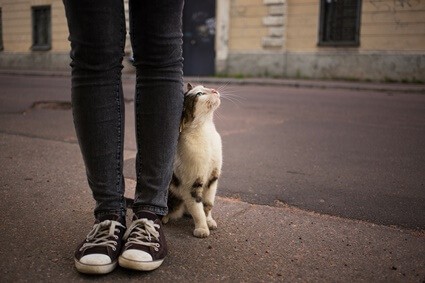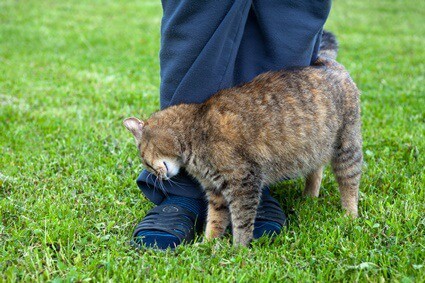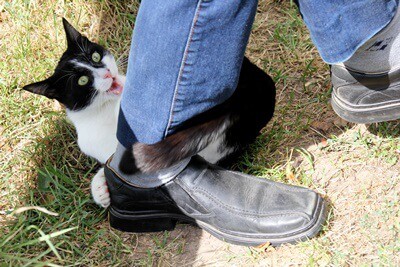Cats have a habit of walking in front of you, so it may appear as if your cat is trying to trip you over. However, tripping is a consequence of instinctive behavior rather than any wilful intent to make you fall over.
A cat will zig-zag or dart in front of you when it wants attention or to herd you in a certain direction. When a cat has separation anxiety, it may try to prevent you from leaving the house. Sometimes, a playful cat will hunt your ankles. Also, walking in front of you can be due to feline dominance.
It’s most likely that your cat wants you to take notice of it. If you take care of its basic living requirements and acknowledge its subtle pleas for attention, your cat is likely to stop walking under your feet all the time.
Why Do Cats Walk Right in Front of You?
Cats get under your feet for various reasons but never to intentionally cause you physical harm. They just know that you cannot ignore this zig-zagging or darting action.
The most common reasons for a cat to walk in front of you include:
- Attention-seeking
- Herding
- Play
- Dominance
- Separation anxiety
- Disorientation
Take time to understand the meaning of your cat’s body language cues. If you can figure out what your cat is telling you, you’ll be able to identify and meet its needs more promptly.
This will make the cat feel more secure, and it won’t consider it necessary to stand in front of you while you walk.
Attention-Seeking
Most often, a cat steps in your path to get your attention.
Your cat will likely have been trying to elicit a response from you already. If you’ve ignored your cat’s verbalizations, it’ll turn to a different tactic.
Your cat wants you to do something, such as provide food or attention. Learn your cat’s body language cues as it’ll behave in certain ways when it’s feeling hungry or playful.
This behavior may also be rooted in memory for your cat. If the cat nuzzled your ankles as a kitten, you might have offered it petting. Your cat will remember this and repeat the action, hoping to elicit the same response.
Herding
Your cat could also be trying to herd you in a certain direction.
When your cat steps in front of you, take a small step back. Wait a moment and see if your cat walks in a certain direction. If it checks to see if you’re following, it wants to show you something or do something.
Often, the cat will lead you to an empty food so that you can feed it. If it takes you to the litter tray, it’s reminding you to clean it. Leading you to a window or door means that the cat saw or heard something or that it wants to go outside.
Note if your cat leads you to a wall, especially if it stops and stares at it intently. Your cat may have heard something inside the wall. It could be something innocuous, but it could be a rodent, bed bug, or termite infestation.
Hunting Play
If your cat runs ahead of you before blocking your path, it’s playing with you. Watch your cat’s body language closely as it engages in this behavior.
If your cat’s tail is pointed upward and curled forward, this is an invitation to play a game. There’s no harm in yielding to your cat’s request, so fetch your cat’s favorite toy and spend some quality time together.
If your cat narrows its eyes, wiggles its rear, and pounces, this suggests that your cat is hunting you. In the absence of live prey, it has chosen you as a moving target.
Train your cat out of this through play. Pursuing a fishing rod toy or a clockwork mouse will sate its instinctive need to hunt. Avoid laser pointers as there’s nothing to catch, and your cat will feel frustrated and start hunting you again.

Dominant Behaviors
Cats are hierarchal animals. If you live with multiple cats, one will likely show dominance over the others. If your cat lives alone, it may attempt to dominate you.
Blocking access is a common dominant behavior in cats. If your cat gets in your way when you walk, it may be deliberately attempting to assert where you can and can’t go.
You can step over the cat, but this is inadvisable as a dominant cat that feels disrespected may become more aggressive. It could start to display other unwelcome behaviors, such as marking clothes with urine.
If this dominant behavior continues, seek expert advice from a feline behaviorist.
Separation Anxiety
Is your cat excessively clingy while you’re in the house? A cat that follows you from room to room, verbalizing to excess, may have separation anxiety.
As Current Biology explains, felines experience two types of attachment to owners:
- Secure attachment: The cat trusts its owner to meet its needs.
- Insecure attachment: The cat worries that an owner will abandon them, leading to separation anxiety.
A cat with separation anxiety will stand in your way when you leave a room. The cat doesn’t want you to leave as it worries that you will never return.
You must enhance the bond of trust with your cat by establishing a reliable routine. Set aside specific times for feeding, play, and grooming each day, and your cat will come to accept this schedule.
Other things that you can do include:
- Arrange for cat-loving friends and neighbors to visit when you’re out
- Leave curtains and drapes open so that your cat can watch birds through a window.
- Fill your home with toys and puzzles
- Get a cat tree to keep it mentally occupied

Disorientation
Has your cat been acting strangely in other ways?
Consider whether your cat may have sustained a blow to the head due to running into something, a road traffic accident, or having a bad fall. If so, your cat may have a concussion.
According to The Veterinary Nursing Journal, cats are commonly admitted to surgery due to concussions. A concussion prevents the brain from sending accurate messages to the nervous system.
Your cat may not have intended to walk in front of you. It may be that your cat has taken an unwitting detour due to crossed wires in the messages from its brain to its legs.
Aside from an uncoordinated gait and trouble walking, symptoms of feline concussion include:
- Spontaneous vomiting
- Swelling around the face
- Staring into space
- Bleeding from the nose, eyes, or mouth
If your cat has a concussion, a veterinarian should check it over. However, mild concussion in cats usually corrects itself after 1-2 weeks of rest.
By walking between your legs or in front of you, a cat isn’t trying to trip you up. Usually, it’s attempting to elicit a response so that you can meet its needs. Food, water, and a clean litter tray are likely explanations.


Nice thanks for writing this. There is a stray cat I feed and he walks in front of me in a horizontal action way back and forth not allowing me to walk. I believe it is separation anxiety I went on vacation for 2 weeks and he probably feels I’m not gonna come back when I leave him daily. Take care